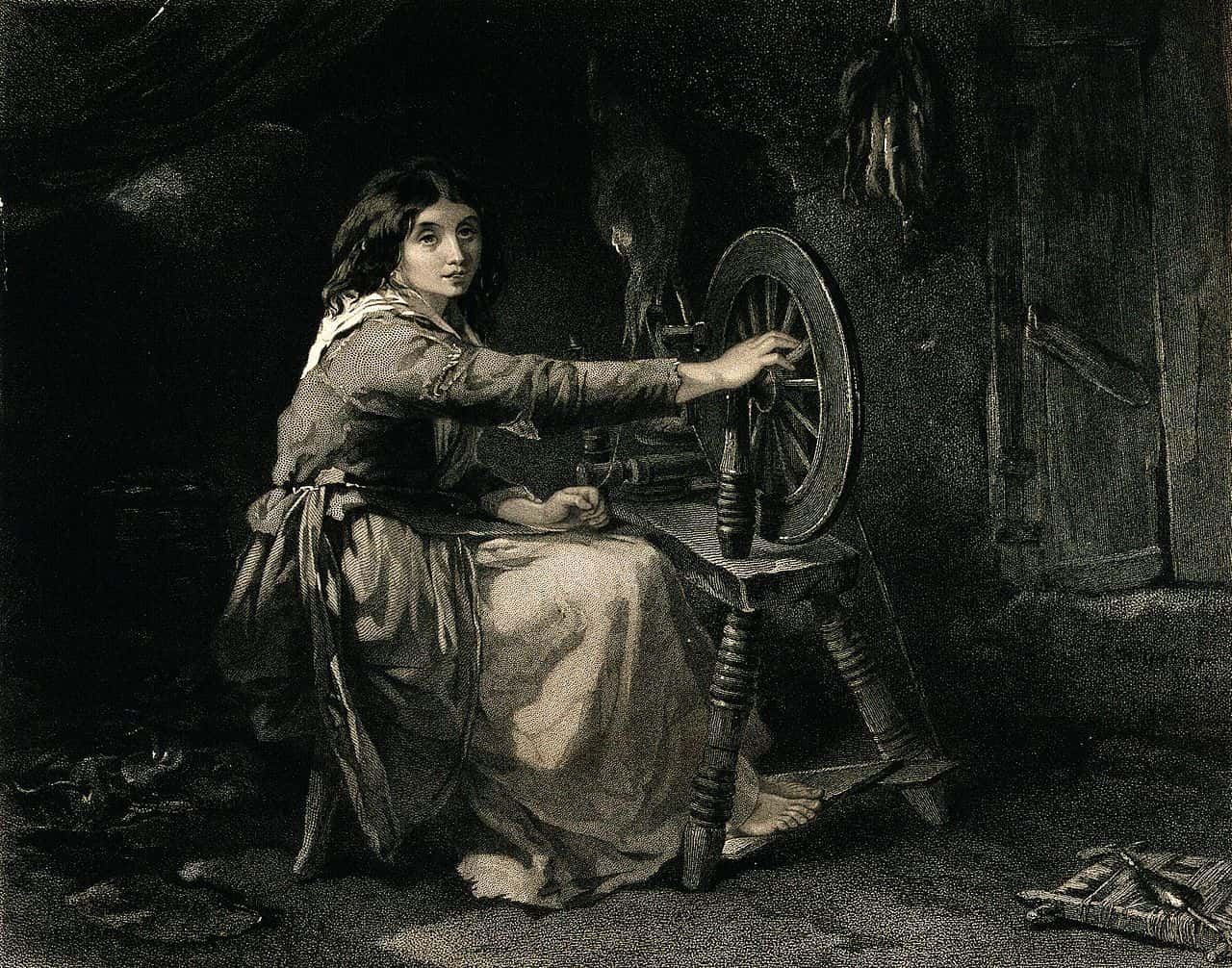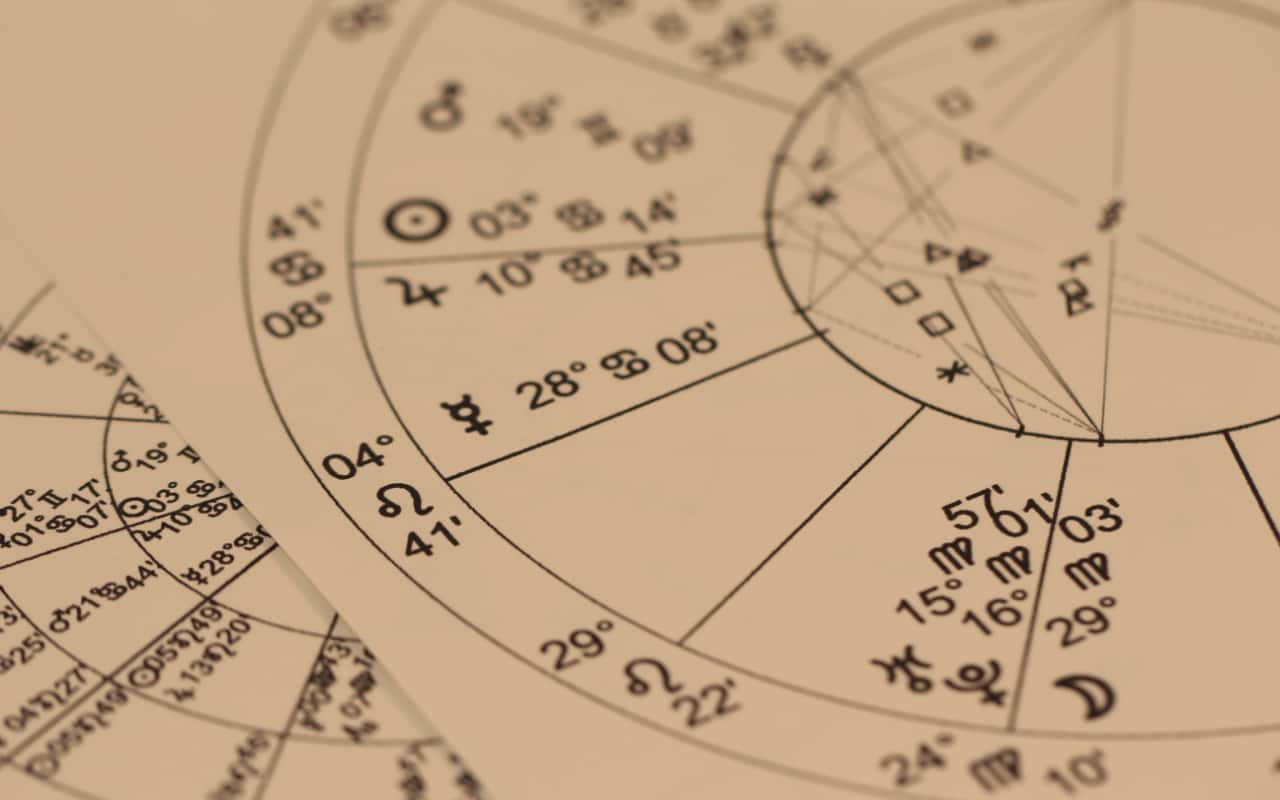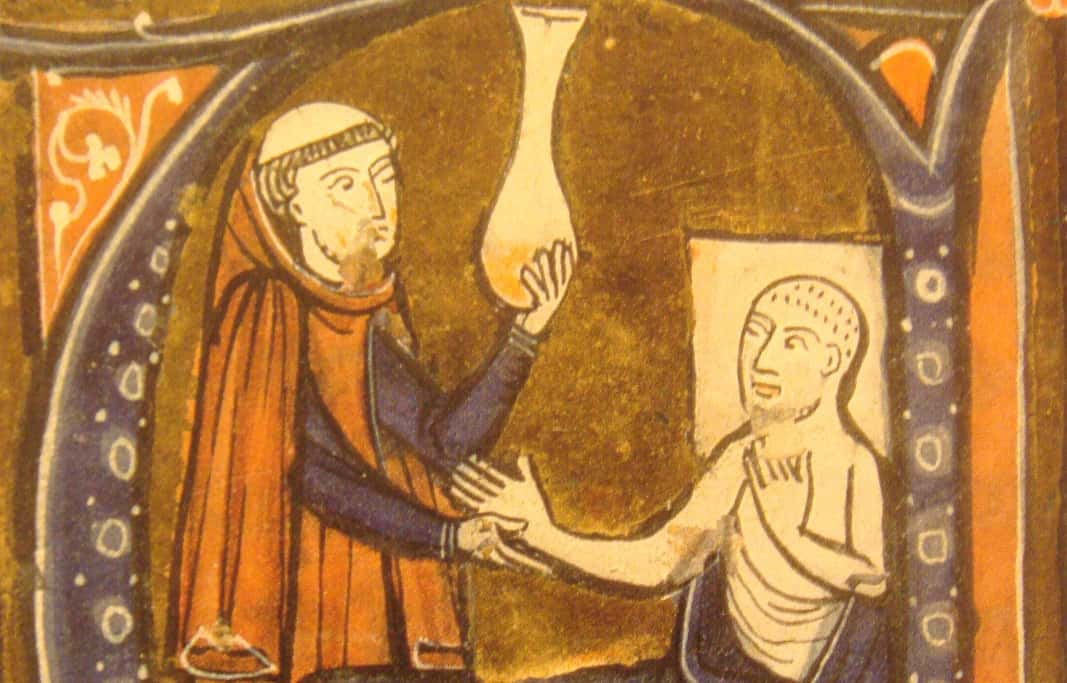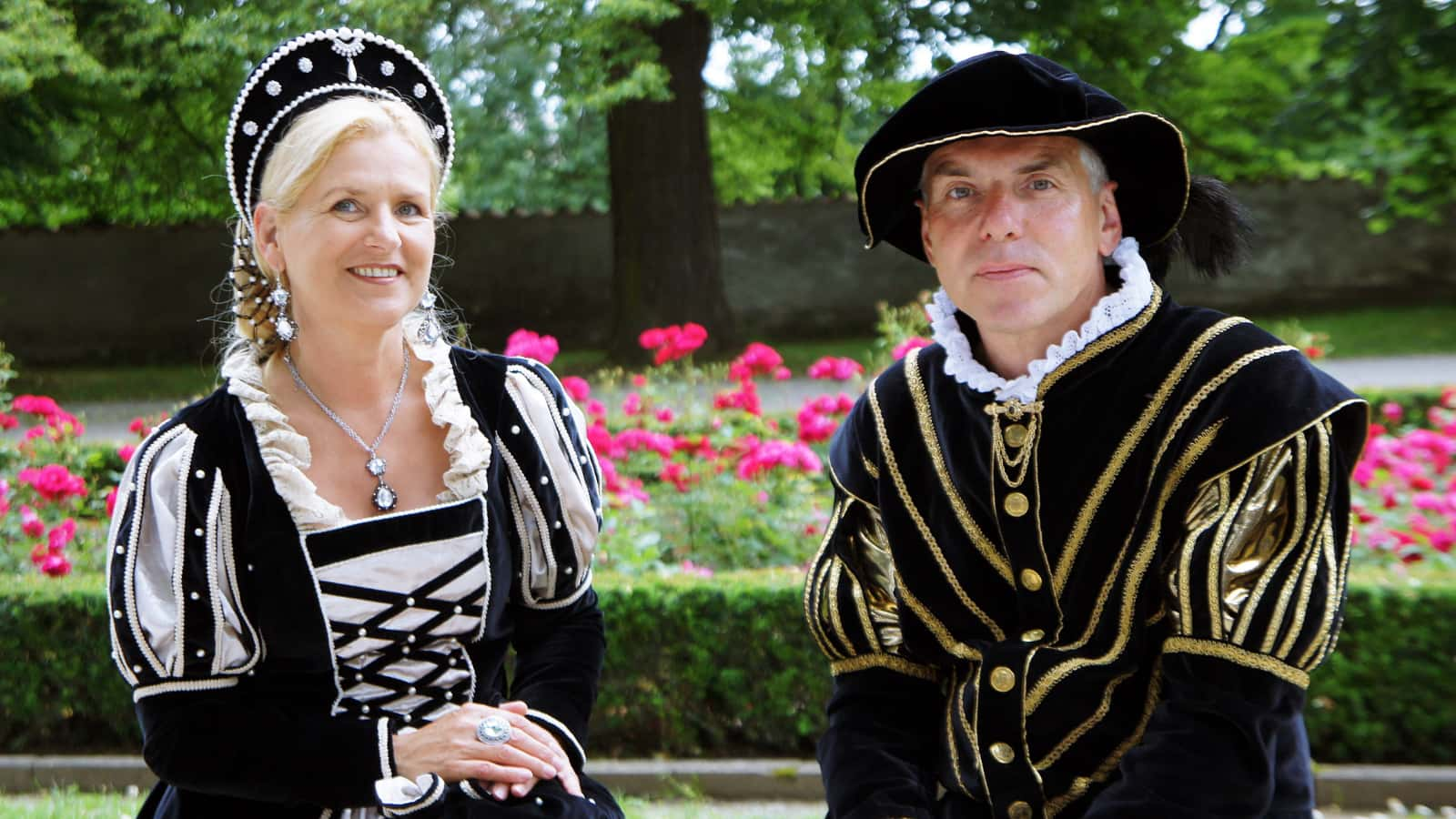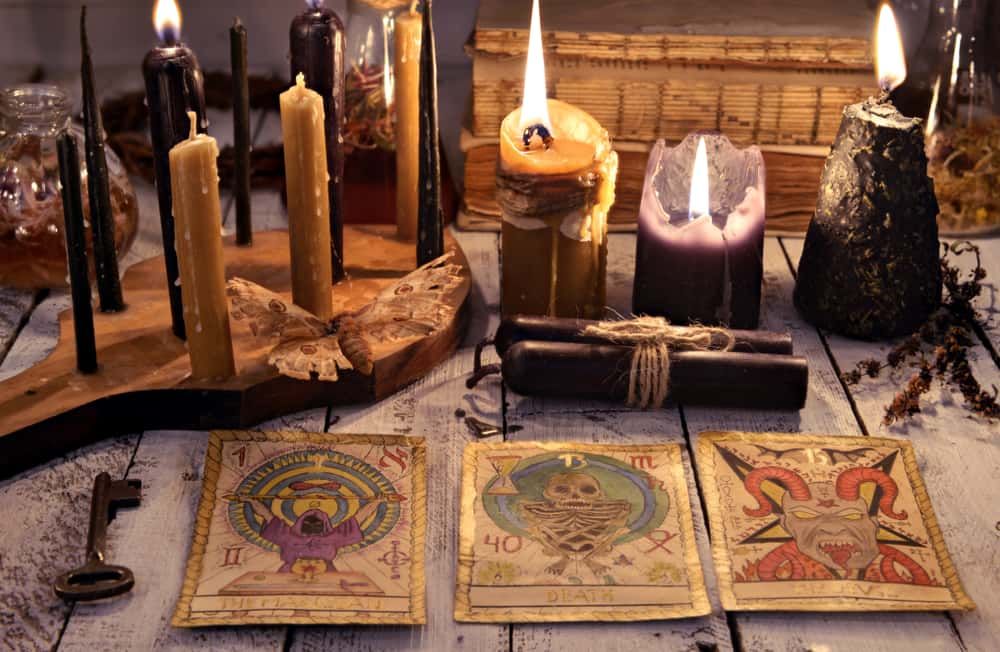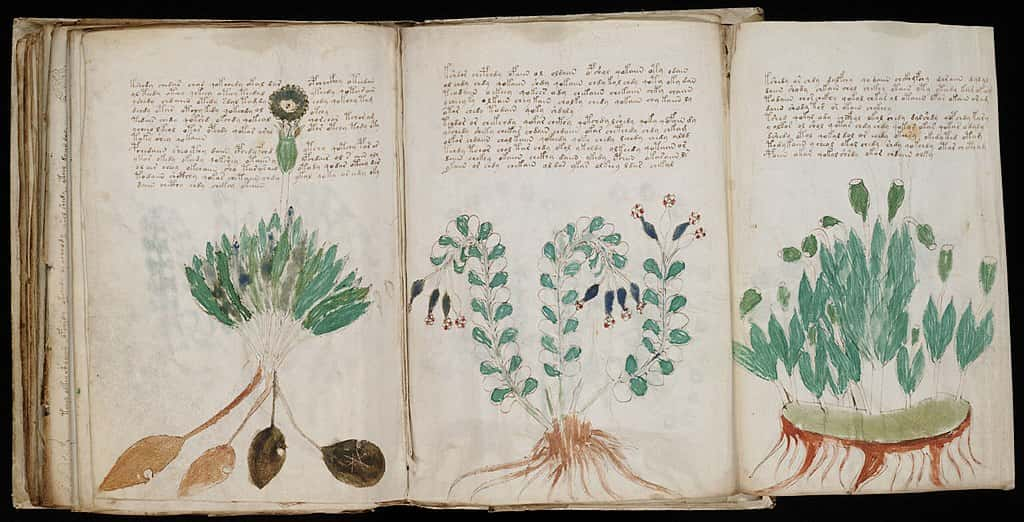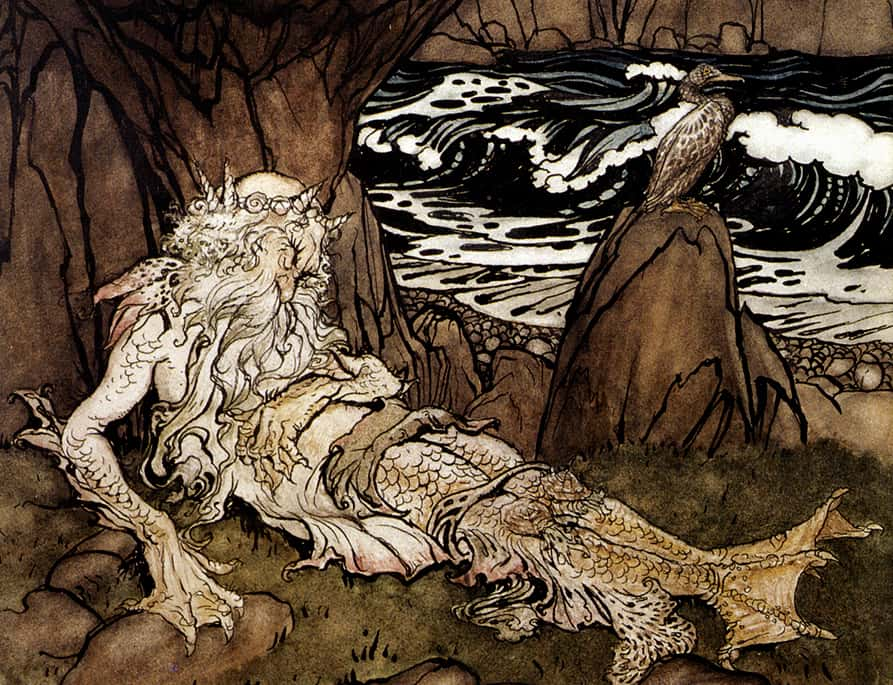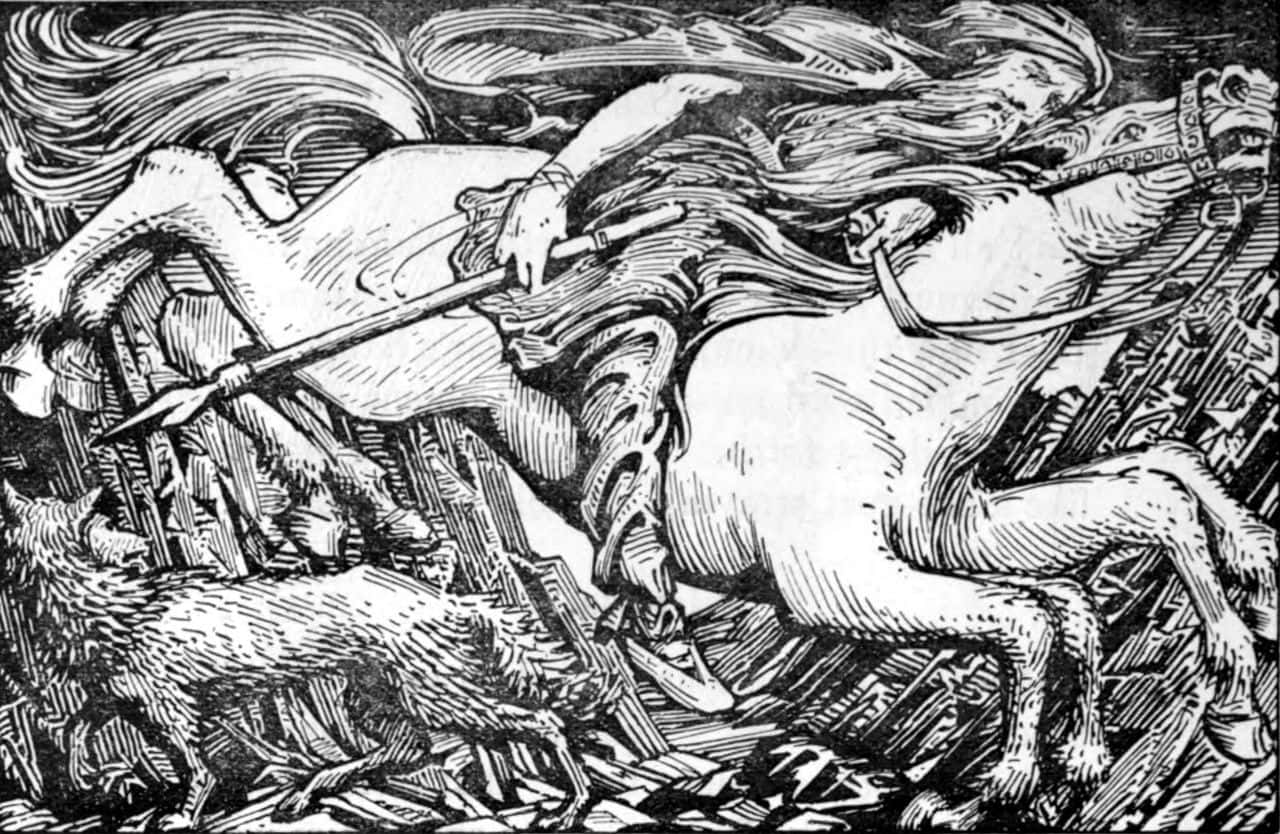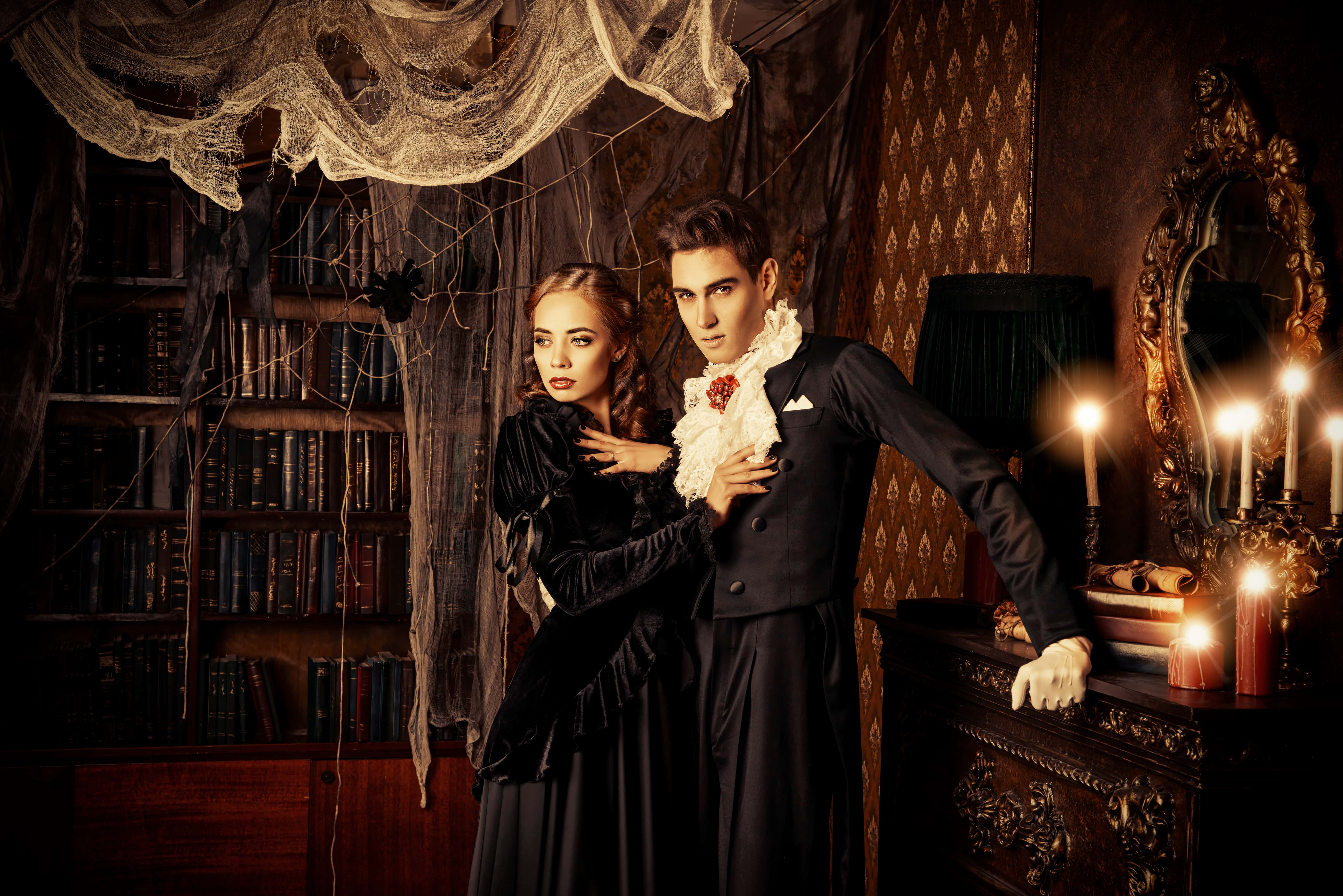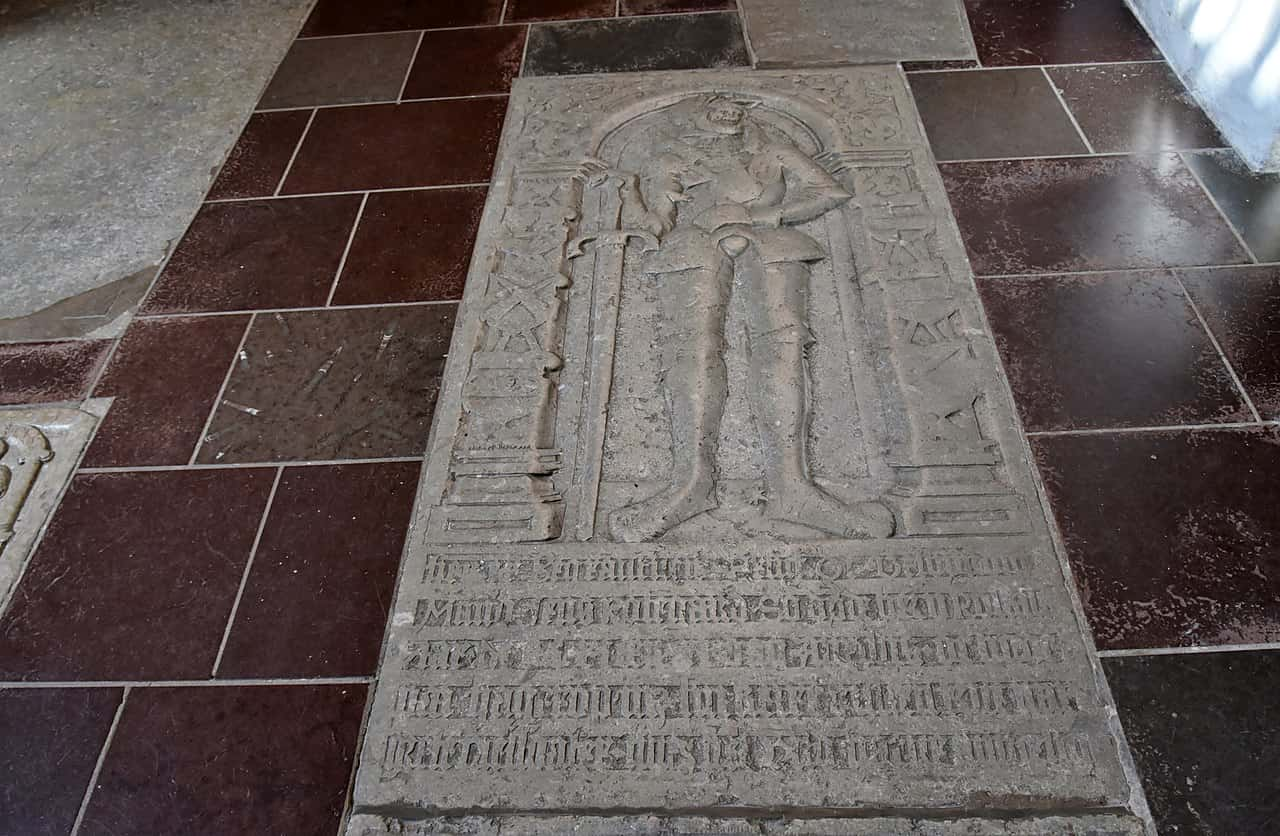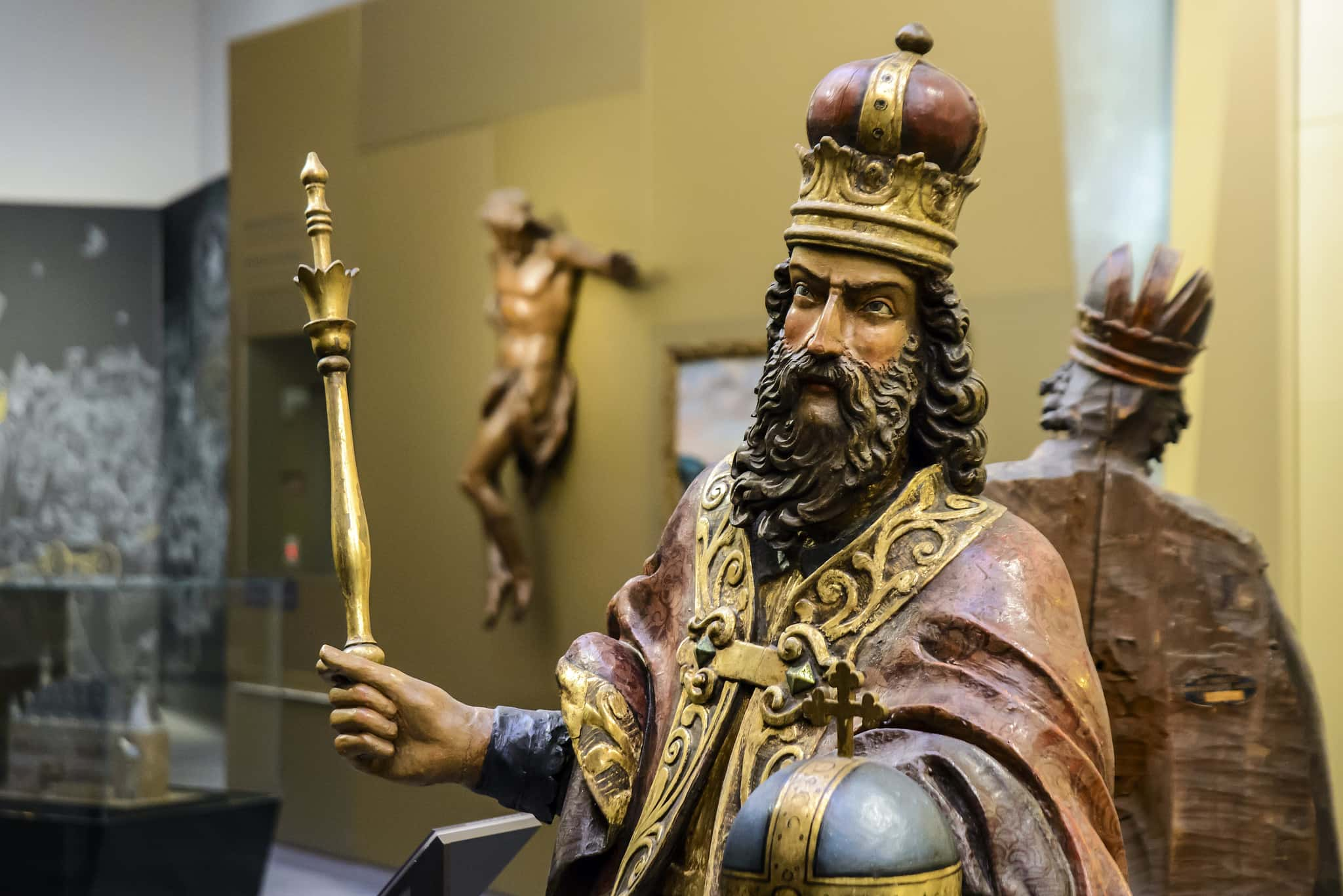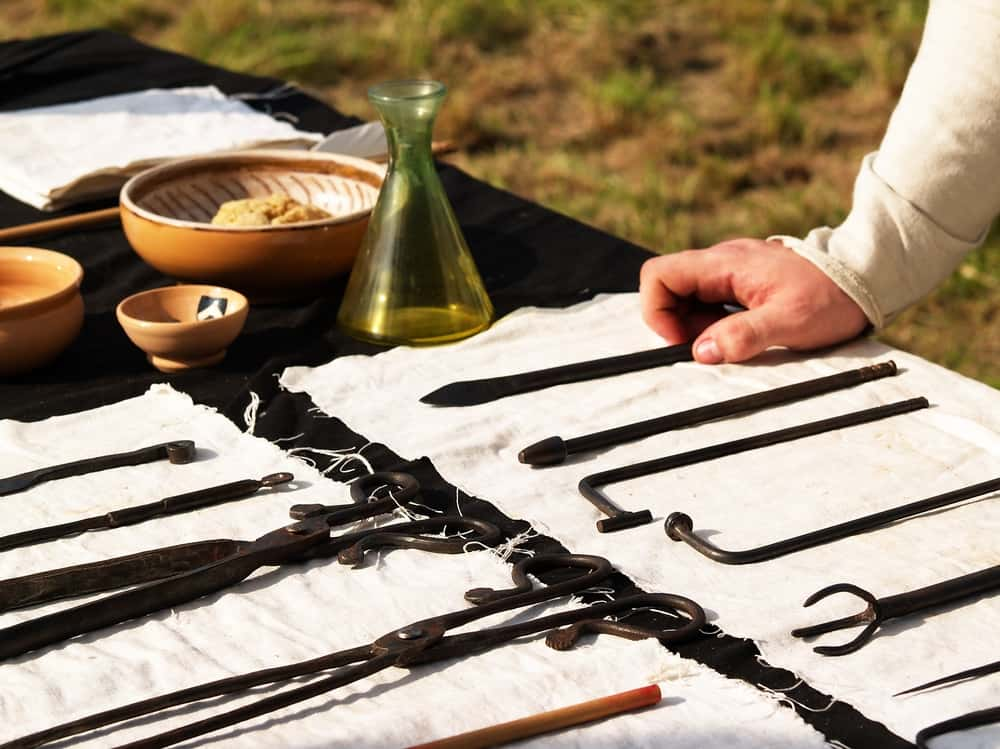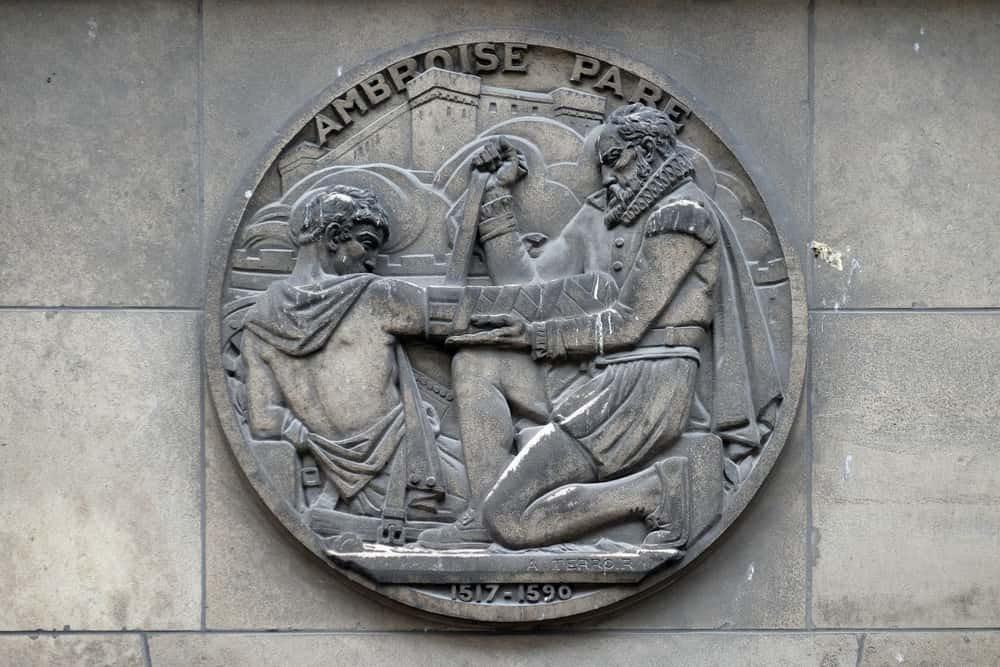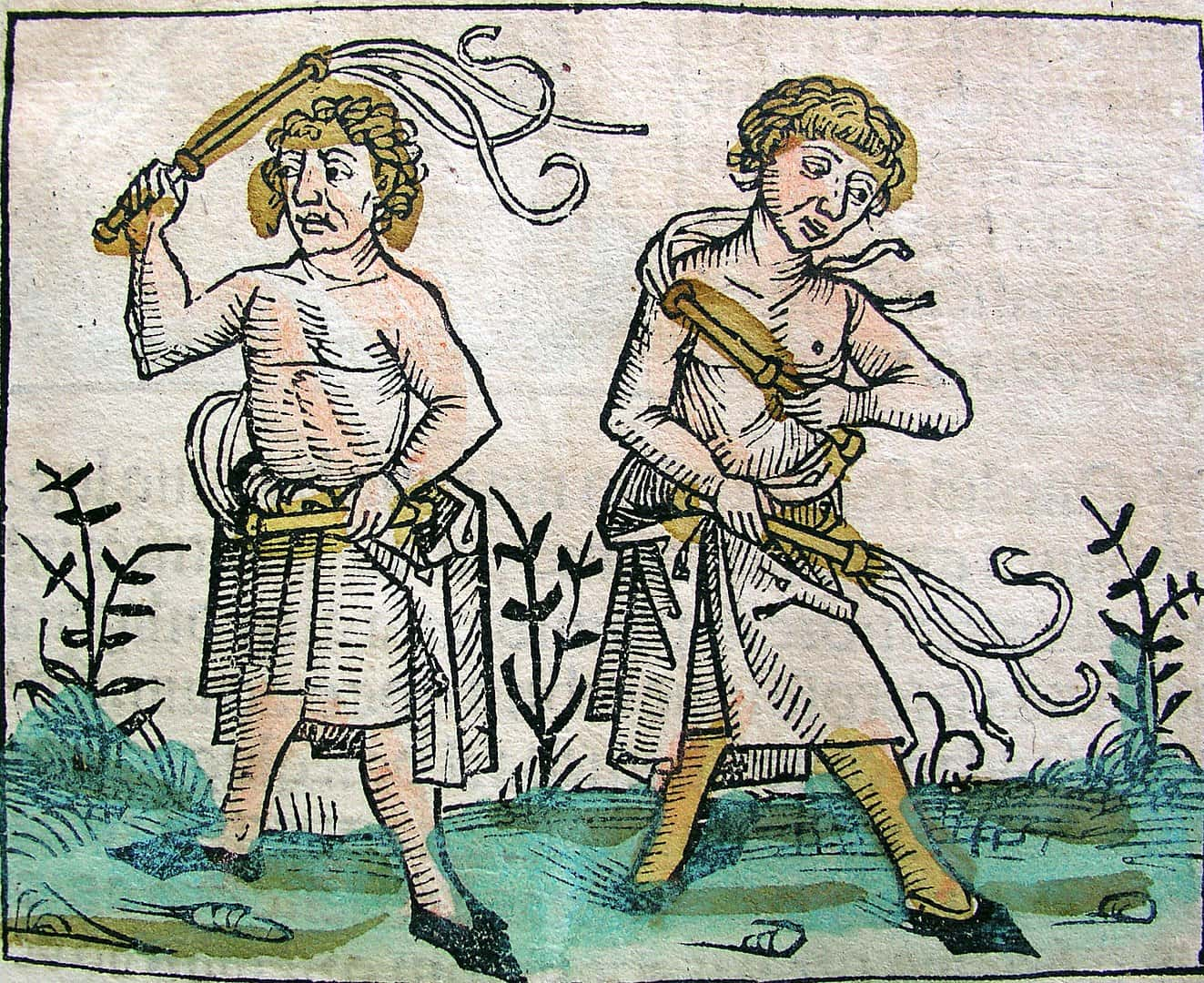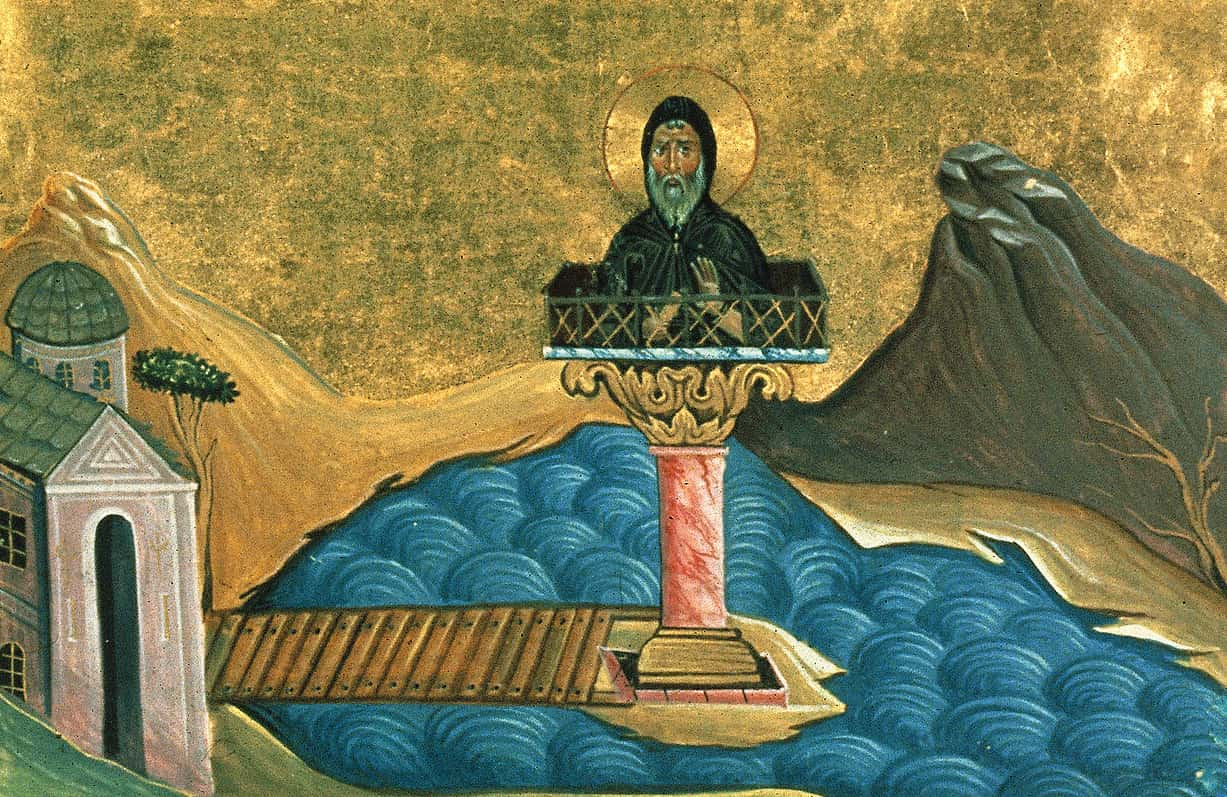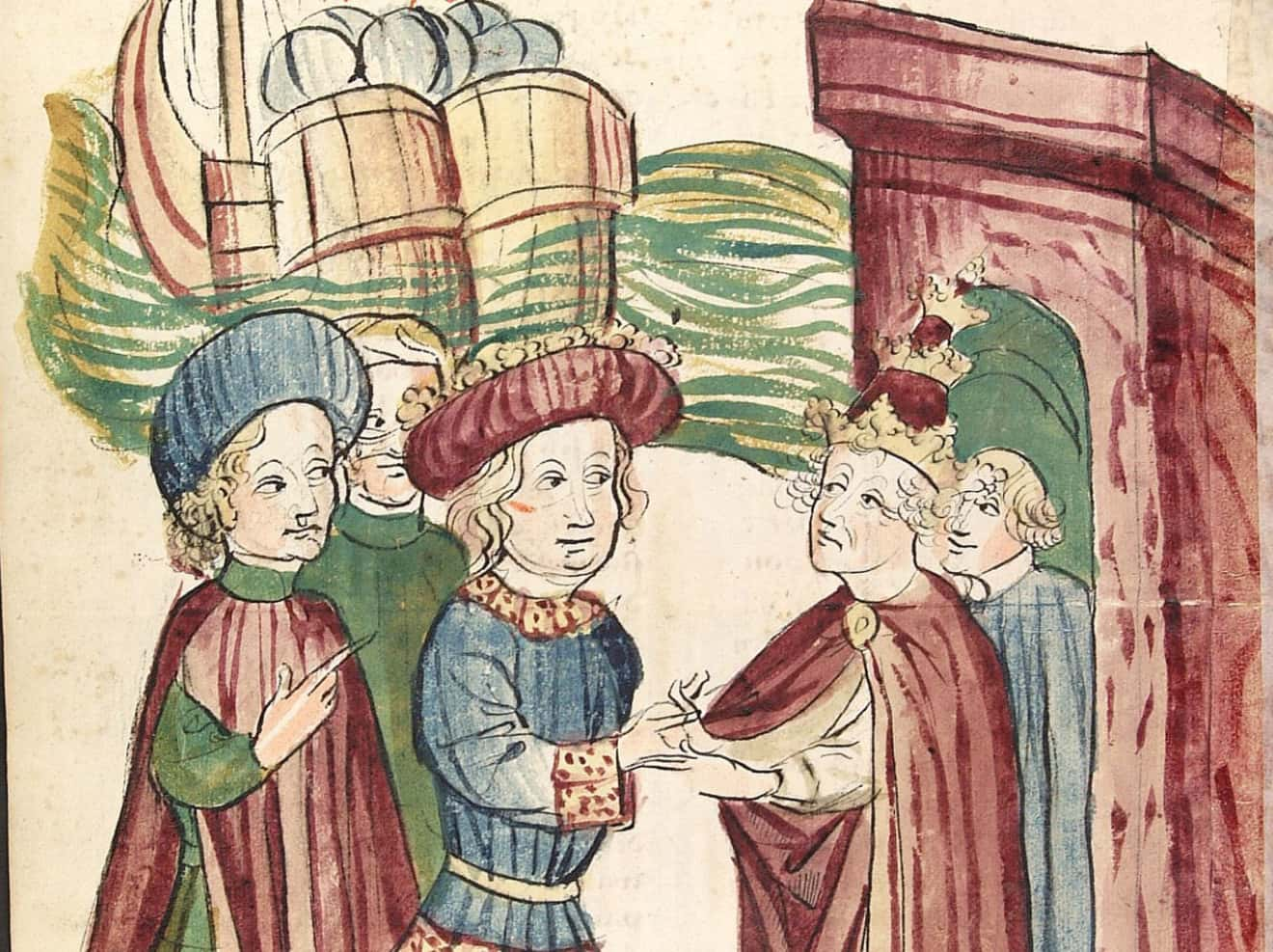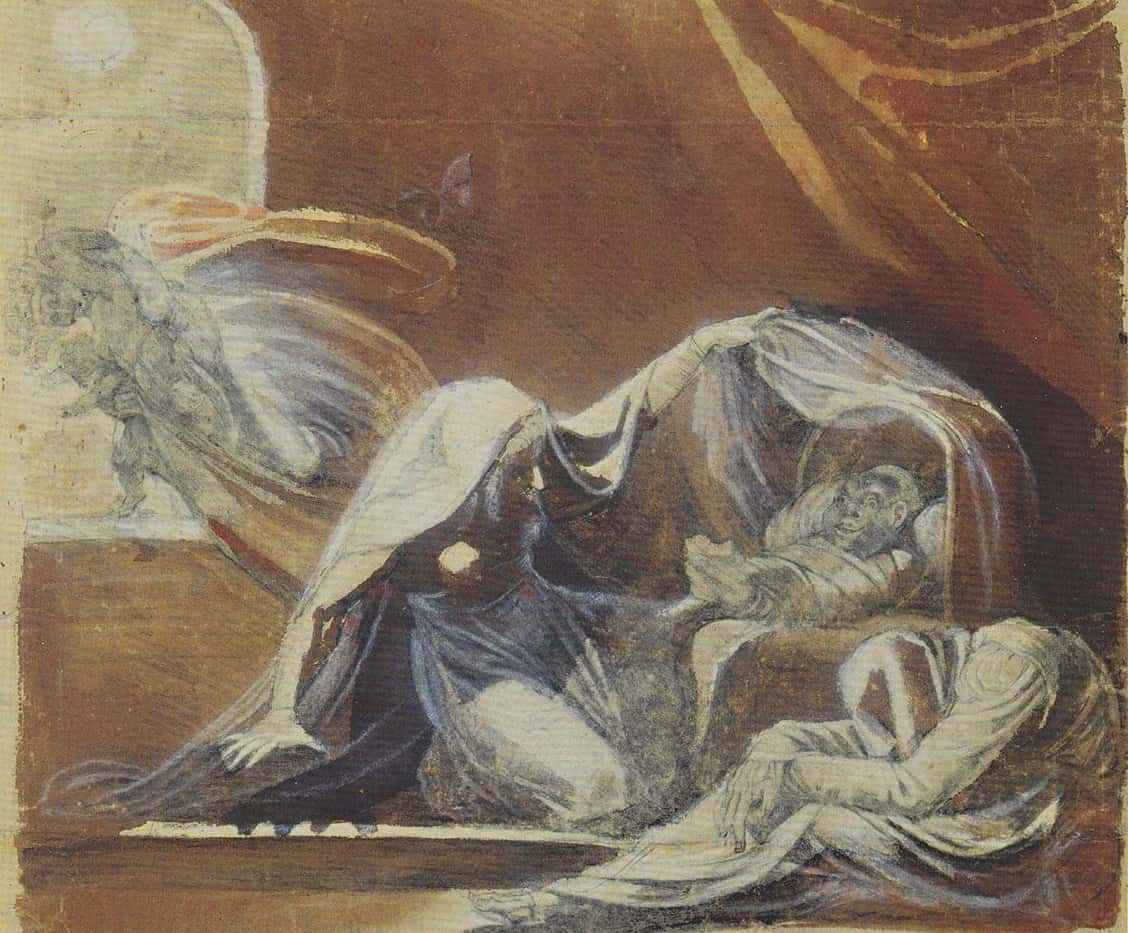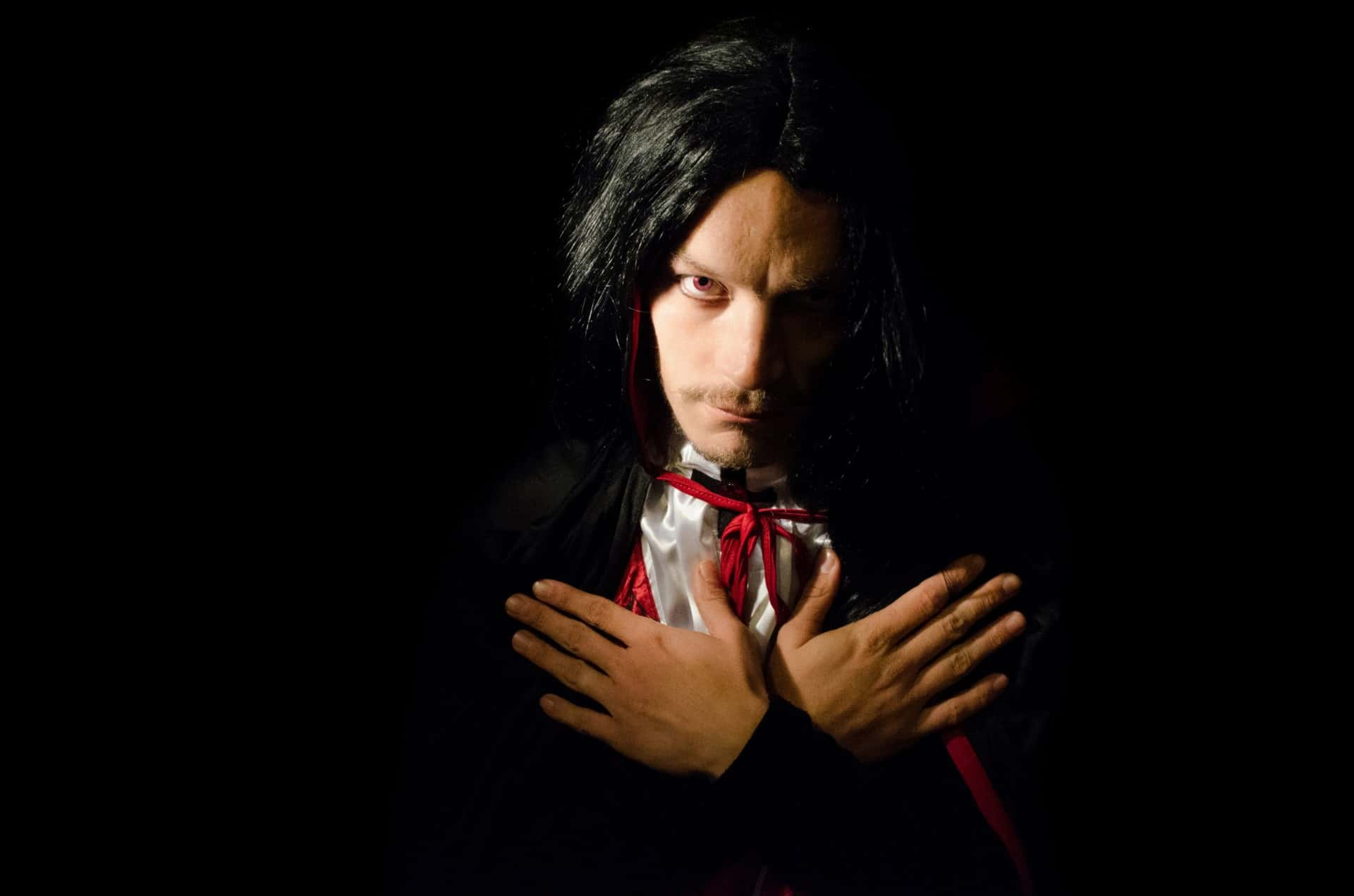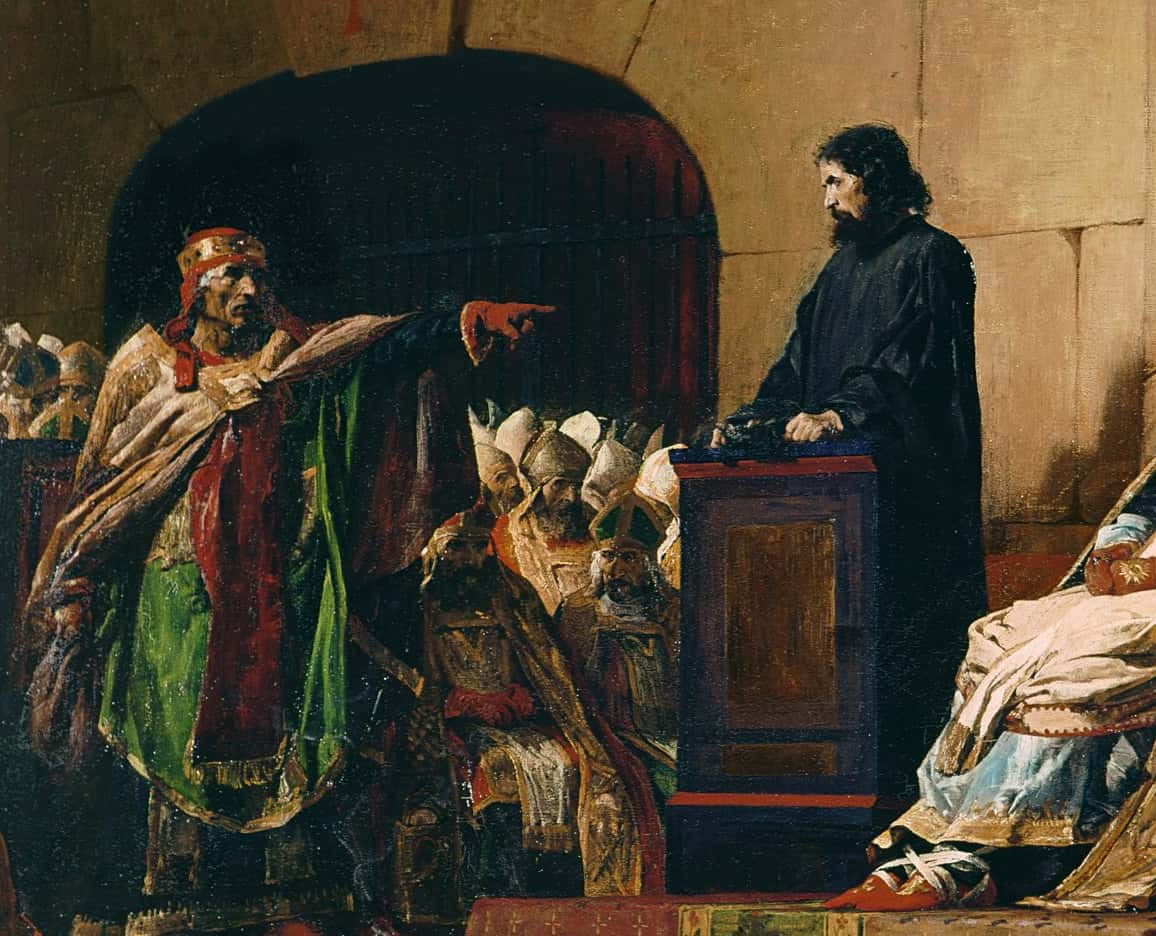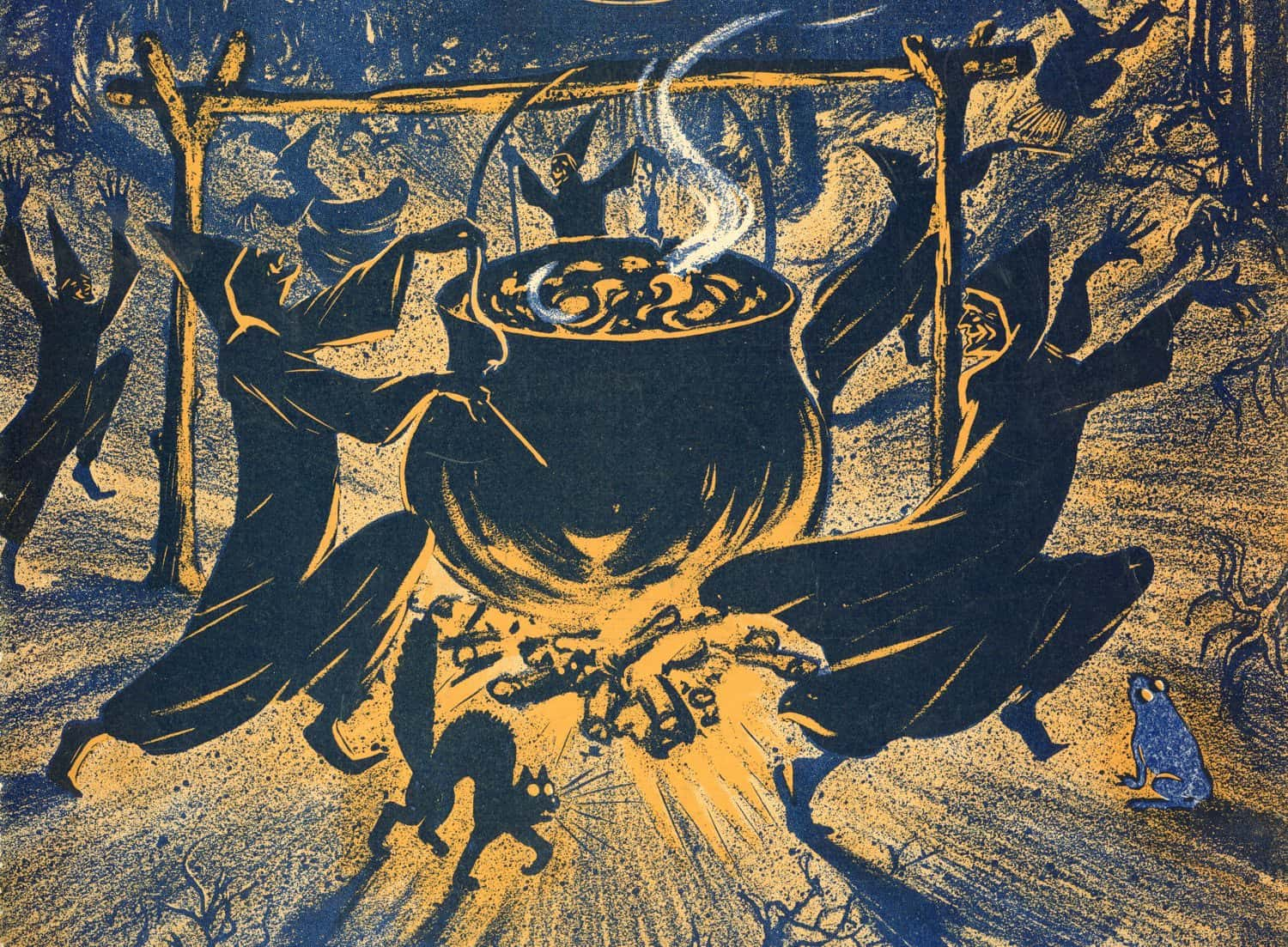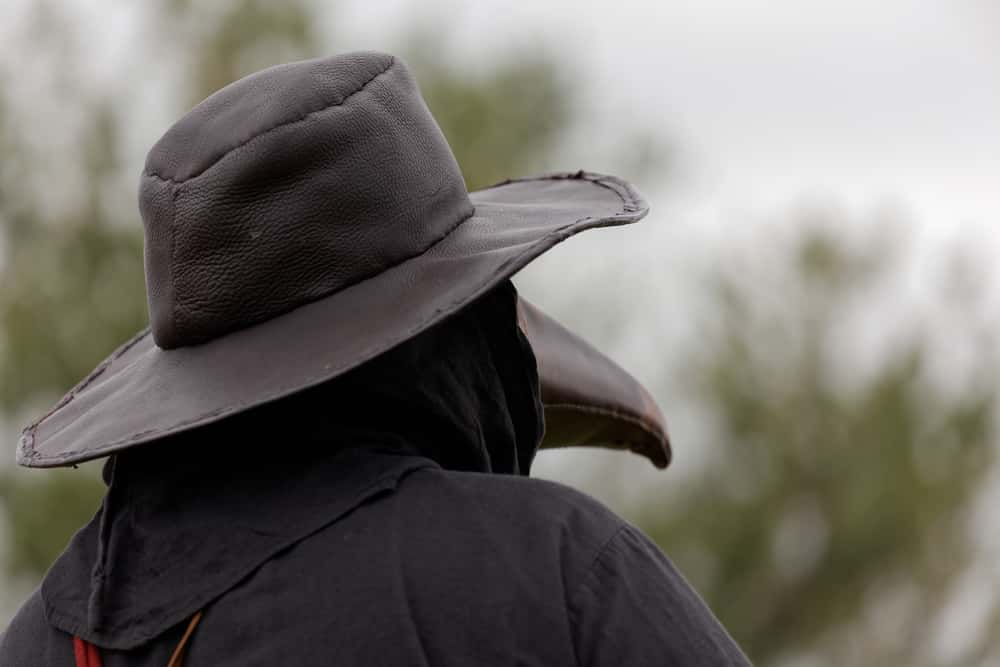What passed for medieval “common sense” might not pass today’s standards for proof, or, um, medical sanitation. From bright ideas about the occult and Bibles co-produced by Satan, to household cures involving hot pokers and animal enemas, the beliefs of the medieval public reflected the gritty times in which people lived (and died). Prepare for one wild ride into the past with these 42 unsettling facts about medieval beliefs.
Medieval Beliefs Facts
1. Golden Cure
Urine was believed to be a great antiseptic. It was certainly good enough for Henry VIII’s surgeon, who abided by a policy that all battle wounds should be rinsed with the stuff. What’s more twisted? It wasn’t a terrible idea when you consider the alternatives; clean water was hard to come by in the Medieval Ages. Might as well use what you got.
2. Sensual Care
In the 16th century, mercury was a common treatment for syphilis and other sexually transmitted diseases. Just apply directly to the nose or mouth or, if you’re feeling trendy, do the “fumigation” method and simply vaporize the substance in a neat, air-freshening steam. Side effects include loose teeth and ulcers of the gum. Rather unsexy.
3. Man-Made Miracles
Cannibalism wasn’t always a taboo. Medieval doctors kept their patients in check with drinkable byproducts of human blood and flesh. “Mummy powder” was a commonplace fixture of 12th-century apothecaries, and these practices even had a name: "corpse medicine." Well into the 17th century, even English kings like Charles II dined to a healthy regime of what he called “King’s Drops,” aka alcohol mixed with crushed human skulls. Salty!
4. Bad Math
Superstitious bias towards the number “13” really took off in the medieval period. Aversion to the number arose from the fact that there were 13 apostles (including Jesus) at the Last Supper. Even in the 16th century, having 13 people together could signal you were a witch. Good thing I don't have that many friends.
5. The Big Sneeze
Blame the medieval age for why you sometimes say, “Bless you!” when someone sneezes. The general assumption has been the “blesser” was sending their goodwill to the sneezer, whose soul had just been ejected from the body via nasal expulsion. Other people note this practice emerged in the time of the Plague. When any sneeze could be your last, might as well get those blessings in while you can!
6. Little Miss Lace & Grace
Medieval Germans viewed clothing made by young girls as very lucky. Specifically, a shirt spun by a girl under seven years of age would bring good luck, and a shirt spun by a girl aged five to seven would even protect the wearer from magic. Likewise, wearing a shirt made from thread spun by a five-year-old girl to court would bring a just verdict. Frankly, this just sounds like a cute way to justify child labor.
7. The Stars Say to Drop That Scalpel
European doctors in the 1500s were legally required to check a patient’s horoscope before performing any direct medical treatment. Imagine getting your surgery delayed because you’re a Rising Taurus and Mercury is in retrograde.
8. The Sky is Falling
Plenty of people today believe that aliens visit the Earth as UFOs, but medieval people didn't know enough about the universe to even conceive of aliens. Don't worry though, they still had their own bananas explanations for strange sights in the air. Many people believed that there was a land in the sky called Magonia and that strange lights in the sky were either Magonian ships coming to steal crops, or else Magonians themselves who had fallen to earth.
9. Bleeding Awesome
Bloodletting was an important part of any medieval doctor’s belief system. A patient had two options: leeches or venesection. With the leeches, a “blood worm” would be administered on the pertinent body part and the creature would, in theory, suck the illness out. Sure, that sounds gross—but it's not as horrifying as the other option: the doctor would just slice open a vein with his “fleam” (razor) and hope for the best.

History's most fascinating stories and darkest secrets, delivered to your inbox daily.
10. And You Thought Buckley's Was Bad
The rule of thumb with medieval medicine was generally: if it does anything, then it's probably working. This led to many medicines that were actively bad for you. For instance, a common remedy for stomach worms would cause brutal diarrhea. Doctors assumed that the diarrhea meant the body was flushing out dead worms, when really, they were just making a bad situation a whole lot worse.
11. No Magic Allowed
In 1456, Johannes Hartlieb put down seven “arts” to be officially forbidden in canon law. These arts were: nigromancy (traditional “dark arts”), geomancy (divination around the earth and dirt), hydromancy (water-based scrying), aeromancy (tossing sand or seeds in the air to read how it settles), pyromancy (reading fire signs), chiromancy (palm-reading), and scapulimancy (reading animal bones). Don't you even dare try one of these!
12. Hard Rock Philosophy
The philosopher’s stone is a central part of medieval mystic mythology. It was a rock believed to be invested with alchemical powers, even offering its user immortality. If you believe medieval legend, the 13th-century intellectual Albertus Magnus passed the infamous stone down to his pupil—the even more famous Thomas Aquinas.
13. Born Numb
In the past, people thought babies were simply too underdeveloped to sense physical distress—and this led to a truly disturbing practice. Surgeries were regularly performed on infants without any attempt at anesthesia. Any crying was believed to be the result of ill-mannered childishness, as opposed to any external forces. Scary to think that “Babies feel pain” is a very recent belief.
14. 5 Reasons Why Not
Famed medieval scholar Albertus Magnus ranked five sexual positions from most to least “morally” acceptable. Since this is a family website, we won’t list them here. But it will surprise few of you that the least offensive position was, from the top, “missionary.”
15. Just Sometimes a Sin
In some periods of the Middle Ages, sex work was not only believed to be acceptable, but it was also marginally encouraged by the Church as a way to curb uncontrolled lusts. Even St. Thomas Aquinas once wrote, “If prostitution were to be suppressed, careless lusts would overthrow society.”
16. Ladies First
In the 13th century, a female orgasm was considered a necessary part of human conception. Granted, that was mostly because they thought female anatomy was just like a man's, only inverted, but you can't win 'em all.
17. Women’s Time to Shine
At least officially, the majority of medieval “magic” practitioners were men. “Female” constructions around ideas of medieval magic, and the subsequent persecution of “witches,” are more common to the early modern age than the middle ages. You can thank Heinrich Kramer’s warnings in his 1487 Hammer of Witches for that feminine connection.
18. Beast for Fashion
Your animal fashion statement could double as a handy token to ward off the ills of medieval living. Some people used seal skin to charm lightning away; others used vulture remains as protective jewelry. Staying safe in the Middle Ages had never been so boho-chic.
19. Co-Authorship From Hell
There were many strange and mysterious tomes scattered across the medieval world—but one was more chilling than any other. “The Devil’s Bible” is a legendary Latin manuscript that’s said to be the product of a monk’s bargain with Satan himself. In the 13th century, a monk was about to be executed for his crimes unless he could compose a single, impressive work in one night. To achieve this impossible task, the monk sold his soul to Satan and produced this 165-pound, three feet long book.
While that’s just a legend, The Devil’s Bible does exist as a real text, and it appears to have been written completely by the hand of a single scribe…
20. The Can’t-Be-Burned Burn Book
It’s said the Vatican’s secret archives still contain original editions of The Grand Grimoire, a black magic textbook that dates back as far as 1421 (though it likely was written in the 19th century). It’s also said that this book is indestructible and impervious even to immolation.
21. It’s Probably Just Doodles
The 15th century Voynich Manuscript is infamous because scholars just can’t agree on what it’s about, or even what language it’s written in. Composed with images of naked ladies, obscure zodiac symbols, and indecipherable herbal recipes, the book inspires no shortage of controversy. Whatever medieval belief system it’s supposed to have upheld, we're betting it was wicked.
22. Angels in the Far Out There Field
When John Dee wasn’t busy advising Queen Elizabeth I, the famed mathematician was trying to contact angels. Dee spent most of his life trying to decipher the strange codex of magic called Aldaraia (sometimes called the Book of Soyga or, less nicely, “the book that kills”) with the hopes that the jumble of magic codes, genealogies, and incantations would aid him in his dark works.
23. Dark Magic 101
One of the most famous dark magic textbooks of the pre-modern ages is the neatly-named The Necromancer’s Manual. Written in 15th century Latin, it is completely about the dark, “evil” magics that contemporaries were told to avoid. It also divides its powers into three sections: illusionist magic (tricks to the human sense), psychological magic (tricks to the human sense of persuasion), and finally divinatory magic (the heavy stuff that lets you see past and future). Finally, a coherent academic index.
24. No Assembly Required
People in the past put a lot of faith in sperm. Human reproduction was barely understood, and this led to a truly bizarre belief about a man's sperm. Specifically, they believed that every sperm contained a fully-formed-and-ready-to-grow person inside, called a "homunculus." It was simply the woman’s job to be the passive incubator for the seed of her male partner, who was the true source of human life. Not sure we’ve gotten over that…
25. The Devil Is in the Details
Don’t blame me for my typos! The devil did it! Or rather, the devil’s special friend, Titivillus. Back when “printing machines” usually meant “a room of monks trying their best,” mistakes were a common part of book reproduction. To explain away these typos, monks made up the charming character of Titivillus, the “patron demon of scribes,” who was the real culprit in poorly proofed work.
Alternatively, Titivillus would also collect every monk’s mistakes into his handy sack and present these errors as testimony against the monk’s entry to Heaven. I’ve never been more grateful for Spellcheck.
26. In the Nowhere of Middle
Before GoogleMaps, many kingdoms believed in the existence of a giant mythical landmass that laid in the middle of the Pacific Ocean. This extra continent alternatively went by the names of “Pacifida,” “Lemuria,” or the simply-put “Mu.”
27. Mrs. Malaise 1493
Unable to wrap their heads around abstract concepts like “communal infection” and “virulent disease,” the common people of Europe often embodied the Plague as “The Pest Maiden.” Sometimes, she emerged in Scandinavian countries as a young lady, surrounded by blue flames and ejecting herself from the mouths of the dead. Other times, she was an older woman with a broom and was accompanied by a man with a shovel.
The man was sometimes merciful, but the older woman was truly horrifying. She offered no hope to her victims, and never let a single one survive.
28. Vile Veggies
Western countries in the medieval ages thought there was something inherently bad about Brussel sprouts. Spiritually, not culinarily. In fact, foodies of Great Britain thought they were outright cursed. So, they cut them in cross shapes. I’d also wash them since this is the medieval times, but hey, different folks, different cross-shaped strokes.
29. Dust Bunnies
Who needs the birds and the bees? People of the Middle Ages believed that worms, insects, and mice could spontaneously manifest from trash and dirt.
30. Sin to Sing
It’s an exaggeration that the medieval churches of Europe outright criminalized a certain combination of notes as too “devilish” to play. Church music was simply too diverse to accommodate such a ban. More likely, monks discouraged composers from using “the Devil’s interval,” or the tritone, in their godly music.
31. Out of Your Head
In Medieval Europe, mental disorders were seen as a sign of demonic possession, moral failing, or sin. Treatments included exorcisms and whipping...if you were lucky. If not, there was an even more chilling remedy in store. It was called trepanning or trephination. This was a simple procedure, really: just drill a hole in the patient’s head to let the demons out!
32. Ballistic Remedies
Cheat on your diet with beaver testicles. In medieval times, beavers were classified as a breed of fish. As a result, consumption of beaver did not count as “eating meat” during a religious fast. Moreover, their furry private bits were very valuable in medicine recipes, a belief that gave birth to the myth that a beaver would bite its own testicles off and throw it at human hunters to escape with its own life.
33. From Under the Sea and Into Your Heart
Move over, Ariel. In this house, we stand for the naked, godless “merman” of Orford. An abbot by the name of Ralph Coggeshall claimed that, in 1161, a group of fishermen captured a hairy, bald, bearded “merman.” Naturally, they chained him up and beat him because he did not speak and knew nothing of their Christian God. When the mob gained some chill, they let their guest out for some exercise in the sea, at which point he broke through their nets and escaped with miraculous agility.
34. Fear the Wild Hunt
People of medieval Britain lived in a healthy fear of spectral phantom huntsmen, who would fling themselves into their homes at night in their eternal hunt for souls. In Germanic lands, the ringleader was sometimes identified as the mythical Odin. If you heard clanging bells at night, your best bet was to lay low on the ground and hope they didn’t swoop you up.
35. Medieval Zombies
There are many ghoulish stories of corpses rising from the dead in the Middle Ages. One 12th century writer, William of Newburgh, recorded several "reliable" accounts of revenants (living dead) and even vampires. In Scotland, Melrose Abbey’s monks reported being visited by a dead priest who kept “groaning and murmuring in an alarming fashion.”
36. Accurate Representation
How would you like to be remembered after your death? If you chose “as a rotting corpse,” you would fit right in with Medieval society. There was a type of resting place called a "transi tomb" that would display a sculpture of the deceased in an advanced state of decomposition, sometimes being eaten by snakes or other creatures.
37. Making Sure
Before the advent of modern medicine and technology, it was difficult to tell if someone who appeared to be dead was actually dead. So, of course, doctors came up with truly disturbing methods to make sure. Ways of checking included yanking out the deceased’s hair, breaking their fingers, and stabbing them with a needle. One medieval poem recounts Charlemagne biting his friend's toe in an effort to wake him up.
38. Stubbed Your Toe? Better Take it Off
Diagnostics were pretty simple for medieval surgeons. They could stitch up and bandage small cuts, but if a wound required more than that, they always resorted to the same grim solution: amputation. Unsurprisingly, surgeons back then got really good at the practice, and they could get the affected limb off in less than a minute. This wasn't just showing off either—before anesthetics, a quick amputation meant a less painful one. It also meant less blood loss, increasing the chances of survival.
39. 50% of the Time, It Works Every Time
Just because these surgeons were really fast at amputating, don't go thinking it worked. Almost half of the patients who had a limb amputated died. I guess a 50% mortality rate is better than 100%?
40. A Shave and a Chop
Most medieval surgeons were actually barbers! Since monks of the era had to keep their heads bald, there was plenty of work for someone who owned a razor. And, since half of medicine was just opening up a vein, barbers put their blades on double-duty and performed bloodlettings and other forms of surgery. Eventually, your barber was responsible for everything from beard trims to pulling teeth to giving enemas!
41. Buzzy Birds
As far as medieval science was concerned, birds = anything that flew. For instance, bees were believed to be very small, strange birds that made honey. Does that mean that the sex talk was just about the birds and the...birds?
42. Salt in Your Ey
People used to blame just about everything bad on evil spirits—and since life in those days was particularly horrible, they assumed these spirits were absolutely everywhere. In fact, the practice of throwing salt over your shoulder stems from the idea that demons were following you at all times. Throwing salt behind you would blind them and protect you from their evil-doing.
43. Far Out Man
Nothing was safe in the medieval era—not even something as simple as bread! Before the annual grain harvest, the only way to bake was to use old, moldy rye. This meant that bread was often infected with a type of fungus called ergot. In some cases, ergot can act similarly to LSD and cause intense hallucinations. Psychedelic, right? Well, more often, it would just make you really sick, if it didn't kill you. Not so groovy...
44. You're a Wizard, Roger!
One guy whose beliefs were remarkably modern was a Franciscan Friar named Roger Bacon. He believed in science and empirical evidence, and some of his predictions are remarkably close to actual modern inventions. He described things like cars, helicopters, steamships, and submarines with remarkable accuracy.
So what did people think of this surprisingly scientific thinker? They laughed off his words as the raving of a crazed wizard. Yeah, that sounds about right...
45. I Still Think This...
Partially because it was practiced by Muslims, many in Europe believed that mathematics was a "black art" akin to sorcery well into 1500s.
46. Whip Your Soul Into Shape
As if life in Medieval Europe wasn't bad enough, some religious fanatics took it upon themselves to make it even worse. Many people believed that "mortification of the flesh" brought you closer to God. For most, this meant kneeling in prayer or maybe fasting or abstinence. Flagellants didn't think that went quite far enough—they had a far more brutal punishment in mind. They took to constantly whipping themselves with a variety of grim tools.
Flagellelism reached its peak during the Black Plague when people assumed God was particularly mad at humanity.
47. A Pillar of Piety
Don't worry, if whipping yourself isn't your bag, that wasn't the only way to mortify your flesh. Monks called "stylites" would climb to the top of a tall pillar and live there, praying, fasting, and preaching until they eventually died of exposure.
48. Anchored to the Church
Not into self-whipping or heights? Then maybe the life of an anchorite is for you. Still in the name of mortifying the flesh, anchorites would seal themselves into a tiny cell attached to a church. There they would stay until they died—however that came about. They couldn't leave for any reason, so if the church burned down or was sacked by raiders, the anchorites went down with the ship, so to speak.
49. Jesus, Take The Rudder
It seems as though medieval monks would do anything to get closer to god. In Ireland, clergymen would take to the sea in simple boats with the belief that if God wanted them to return to land, He would see to it. According to the Norse Sagas, some of these monks were waiting for the Vikings when they discovered Iceland.
One story even posits that a monk named St. Brendan was actually the first European to discover North American during one of these holy voyages.
50. Sea-Level
Medieval people had a unique ability to blatantly ignore what they saw with their own eyes—especially if it contradicted the Bible. For instance, because Genesis 1 described "waters above the firmament," in 1212, Holy Roman Emperor Otto IV declared that "the sea is higher than the land...above our habitation...either in or on the air." I don't even know where to begin with this one...
51. You’re Not the Father!
Just giving birth to a kid was hard enough medieval Britain. The public certainly didn’t need more fears of kidnapping fairies injected into its popular imagination. But alas, it was believed that nymphs could, would, and did steal healthy children away from parents and replace them with usually sicker, doomed replacement kids called “changelings.” Sadly, this led to an utterly heartbreaking practice.
Parents who gave birth to sickly children would often shun their own baby, assuming it was merely a changeling, while believing that their real child had been taken away from them.
52. Definitely a Turn-Off
Birth control was quite difficult in medieval times, though it was helped by the belief that the best time to conceive was during menstruation. Contraception methods included wearing the testicles of a weasel, the earwax or uterus of a mule, a bone from a black cat, or donkey dung around your neck. I mean, that’s one way to make a man keep his distance.
53. Buffy the Medieval Vampire Slayer
Although the sophisticated vampires of our popular imagination come from 19th-century horror literature, these fanged beasts have progenitors from as early as the 11th century. Medieval vampires were usually thought to be real corpses raised back from the dead. One story tells of a cuckold who died of grief, but whose neighbors insisted he was still hanging around and spreading illness—so they decided to resort to drastic measures.
Naturally, the village opened his grave and impaled him with a stake just to be sure.
54. The Cadaver Synod
Some people hold on to their grudges a bit too long. In 897, Pope Stephen VI had the remains of his predecessor, Pope Formosus, dug up for a posthumous trial. It’s not entirely clear what he wanted to accomplish, since Formosus had already been excommunicated, but Stephen VI found Formosus guilty, chopped off his blessing fingers, and reburied him. Stephen VI then had Formosus’s corpse exhumed a second time, and thrown in the river Tiber.
55. Mystery Man
Anne of Cleves is now infamous as Henry’s rejected queen, but modern historians suggest a more disturbing reason for his disgust. It was a common medieval belief that two people, especially nobles, ought to be wed without having ever seen each other—and this bizarre custom may have cost Anne her life. While Anne’s party was making their way to London, they stopped on New Year’s Day 1540 at Rochester, where she took time to look at bull-baiting from the window. Suddenly, an old burly stranger entered the room—and everything went horribly wrong.
 The Tudors (2007–2010), Showtime Networks
The Tudors (2007–2010), Showtime Networks
56. Love Is Blind
You see, this stranger was really Henry VIII in disguise. He had wanted to creep in and get a sneak peek of his new bride-to-be. He also expected that she would see through his costume via the power of “true love”...or something. Spoiler: This was not a good idea. When he approached Anne, her response made his blood run cold.
 The Tudors (2007–2010), Showtime Networks
The Tudors (2007–2010), Showtime Networks
57. Why Don't You Understand My Cosplay?
Depending on the account, either Henry tried to get Anne's attention and was politely ignored, or he outright tried to kiss and grope her, which understandably caused the young woman to ring the alarms about a strange dude harassing her. Either way, it was utterly disastrous, and Henry left the encounter angry, embarrassed, and possibly ready to take revenge...
 The Tudors (2007–2010), Showtime Networks
The Tudors (2007–2010), Showtime Networks
58. You Don't Fire Me, I Quit
Some modern historians believe that this ill-fated early encounter between Anne of Cleves and Henry VIII sealed her fate. According to them, Anne's lack of enthusiasm for Henry (even in disguise) made the king put up his defenses. If she was unimpressed with him, he may have decided to be unimpressed with her no matter what. And the rest, as they say, is history.
 The Tudors (2007–2010), Showtime Networks
The Tudors (2007–2010), Showtime Networks
59. Wagging Tails
It was a common belief that witches kept male genitalia as house pets, even going as far as to feed them and house them in nests. Puts a new spin on My Pet Rock, right?
60. A Chicken a Day
As you can imagine, the Black Death and medieval medicine didn't exactly mix well. People had no idea what caused the disease, and even less of an idea what cured it—so they tried some truly insane remedies. Many people believed that pressing the shaved bottom of a live chicken against the boils of an infected person was the only solution. The only problem was that the chickens then also became infected and helped spread the disease.
Also (and this is going to surprise you), it didn't work. Turns out shaved chicken bums are exactly 0% more medically useful than regular old people-bums.
61. Boar You to Death
Nothing gets earthier than a boar bile enema. Administered by “clysters”—large, long, metal syringes—they can’t have been a comfortable way to pump medicine in medieval subjects. But where they truly that awful? Louis XIV “The Sun King” of France had as many as 2,000 of these during his lifetime.
62. Cure You or Kill You
Some of the cures physicians used for the Plague actually made things worse: Doctors would burst plague boils, which only helped spread infection. Another treatment involved applying human excrement to the boils, which probably caused entirely new diseases in the victim, on top of the fact that they, you know, applied human excrement to plague boils.
63. A Literal Nightmare
Nobody wants cataracts, but you really didn't want them in the medieval ages. Cataract surgery involved a surgeon (ie. a barber) jamming a huge needle into your eye to push your cornea to the back of the eye socket. Because that's what you want the last thing you ever see to be: your hairdresser jamming an ice pick into your eye!
64. Give ‘Em the Hokey-Pokey
Got hemorrhoids? A medieval monk would tell you to take a hot poker to the sore spots and ease those woes. This was standard until the 12th century, when a Jewish doctor by the name of Moses Maimonides challenged this medical hot take. Instead, he suggested that a good bath would do the (less painful) trick.
Sources: 1, 2, 3, 4, 5, 6, 7, 8, 9, 10, 11, 12, 13, 14, 15, 16, 17, 18, 19, 20, 21, 22, 23, 24, 25, 26, 27, 28, 29, 30, 31, 32, 33, 34, 35, 36, 37, 38







